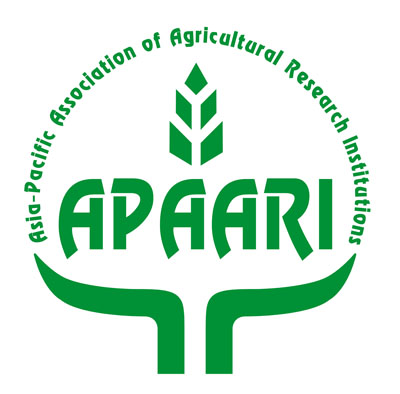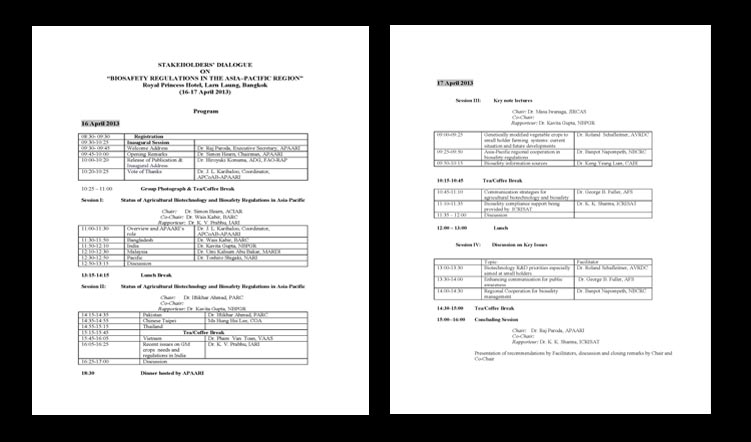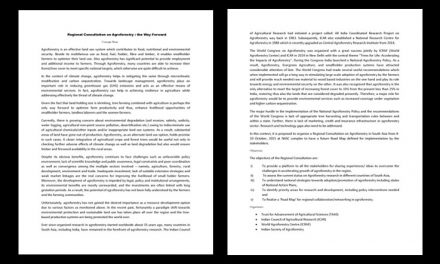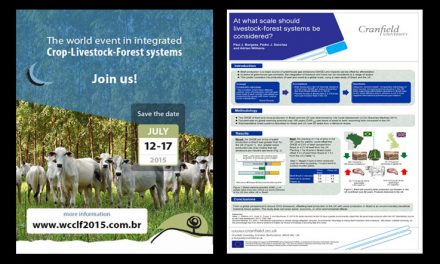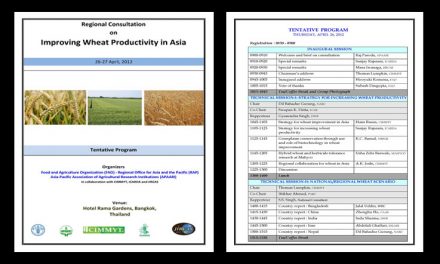Concept Note
The last few years have seen a slow down of growth in agricultural production in several Asia-Pacific countries leading to food shortages and spiralling food prices. The poor and vulnerable sections have been especially hard hit causing the recent surge in hungry and undernourished people. Under the prevailing conditions, most of the developing countries of the region will not be able to meet the Millennium Development Goals of halving poverty and hunger by 2015. Providing sufficient quality and quantity of food has technical, but also social, political and economic dimensions that require immediate attention. One of the means of addressing the need for increased productivity is the use of new biological options including biotechnologies.
Most countries recognize the significant role of biotechnology in meeting the challenges of food and nutrition security. Among the vast array of biotechnological tools currently under use, GM technology has the potential to increase productivity, profitability and sustainability of farm production systems, including small farm holdings. Since the first farm level cultivation of GM crops in 1996, the global area under these reached 148 million hectares (mha) in 2011 spread over 29 countries. In India, just 8 years since its first release, Bt cotton area has increased to a staggering 9.4 mha comprising nearly 86% of the total 11 mha under cotton cultivation. Bt maize in the Philippines, grown for the first time in 2003, covered an area of 0.5 mha in 2010. In China, GM cotton, papaya, tomato, sweet pepper and poplar are being grown over 3.5 mha while approval was granted in 2009 to GM rice and maize. Several studies made on the performance and impact of GM crops have shown that farmers, irrespective of their farm size, have benefited through increased yield and reduced pesticide use which converted into higher profits and household incomes as well as increased aggregate employment.
While this potential of GM technology is well recognized, strong concerns exist over its likely risks to human health and environment and the extent to which these technologies are accessible and effective solutions for resource-poor smallholder farmers. It is agreed that application of GM technology must be accompanied by systematic assessment of potential impacts on food and feed safety and safety of environment, including the diversity of flora and fauna and consideration of mechanisms enabling its access without increasing the debt burden and economic risks to farmers. Moreover, GM is not the only pathway available and for which awareness of genomic technologies is required. Many of the underlying scientific skills required relate to genomics-assisted breeding, which has seen greatly increased recent use among the major private companies as public concerns have been raised over GM and has relevance and use for minor crops as well as the major staples. Countries clearly require skills in these areas and wider awareness of the implications of different technologies to be able to obtain full value from crop molecular genomics.
The Convention on Biological Diversity (CBD) while acknowledging the potential of biotechnology in meeting critical needs for food, agriculture and health, seeks to ensure the development of appropriate procedures to enhance the safety of biotechnological processes and products. The Cartagena Protocol on Biosafety to the CBD, to which most of the Asia-Pacific countries are parties, is a legally binding agreement to ensure adequate levels of protection for safe transfer, handling and use of LMOs (Living Modified Organisms) resulting from modern biotechnology that may have adverse effect on human health, and conservation and sustainable use of biological diversity.
A number of other international instruments contribute to biosafety with respect to GM technology. The General Agreement on Trade and Tariffs of the World Trade Organization (WTO) allows governments to act on trade in order to protect human, animal and plant life or health. Three standard-setting bodies recognized under the WTO’s Sanitary and Phytosanitary Measures (WTO-SPS Agreement), namely the International Plant Protection Convention (IPPC), the Codex Alimentarius Commission (CAC) and the World Organization for Animal Health (OIE) address different aspects of biosafety, including environmental and food safety.
There are also legitimate concerns to consider regarding Intellectual Property Rights (IPR) and equitable access. Conventions, agreements and their associated instruments have been designed to sustain the public goods dimensions of these innovations, including for example the International Treaty on Plant Genetic Resources for Food and Agriculture (ITPGRFA), but there are also underlying practical and communication issues regarding achieving informed access to new technologies for resource-poor farmers in objective ways whereby they can have clear understanding of the relative merits, advantages and disadvantages of alternative ways to address their challenges, in order to inform their decision making
In conformity with their national and international obligations, several Asia-Pacific countries have put in place legislative measures to manage the potential risks associated with GM technology. The regulatory systems vary across countries; some have developed entirely new GM specific biosafety systems while others have modified existing regulations to address biosafety issues. The legal instruments used for the purpose have been new or modified laws, acts, decrees, guidelines and rules. Alongside, administrative systems and infrastructure have been developed to operationalize the legal instruments. Adopting one or the other approach, a number of countries have currently in place regulations on development, contained use, environmental release, commercialization and import of GM crops and products. Several other countries have their biosafety regulations at drafting or implementation stages. However, there is little conformity among national regulations or consistency among national capabilities to implement them, which become impediments to rapid diffusion of useful technologies.
Asia-Pacific Consortium on Agricultural Biotechnology (APCoAB), a program of the Asia-Pacific Association of Agricultural Research Institutions (APAARI) has been promoting appropriate use of agricultural biotechnologies to increase agricultural productivity and incomes of farmers in the Asia-Pacific region. It serves as a forum for stakeholders to address common issues of research, development and commercialization of agricultural biotechnology in the region. In 2006, APCoAB organized a “Workshop on Biosafety Regulations and the need for harmonizing them in the Asia-Pacific Region” in which CBD Biosafety National Focal Points of 12 countries of the region and other technical experts participated. The objective was to identify areas of regulatory harmonization so as to facilitate sharing of benefits of the technology by farmers across the region. A unanimous recommendation of the workshop was to collate information on biosafety regulations, which would help in taking informed decisions regarding specific areas and modalities of harmonization. Accordingly, a publication entitled “Biosafety Regulations of Asia-Pacific Countries” was brought out by APCoAB in 2008 with the support of FAO which detailed biosafety regulations existing in 39 countries of Asia and the Pacific. The publication is available at www.apcoab.org.
Since the publication of this compilation, new developments have taken place in a number of Asia-Pacific countries with respect to framing and implementation of biosafety regulations. Besides, new scientific knowledge and tools have been developed that address some of the safety concerns related to GM products. It is thus proposed to organize a dialogue involving technical experts in biotechnology, biosafety and international regulations; national biosafety regulators; and include the perspectives of farmers and other stakeholders to share advanced knowledge and information on biosafety and related issues and identify areas of regional and sub-regional cooperation in the field of biosafety.The workshop will examine the extent to which this awareness has improved and has resulted in harmonization among countries or other impacts or has benefited the research sector in their work. Also, how the information has been communicated with farmers, consumers, environmentalists and other interested parties and what are the result of this communication.
The Stakeholders’ Dialogue on Biosafety Regulations in the Asia-Pacific Region organized by APCoAB-APAARI and being held in Bangkok, Thailand on 16 – 17 April 2013, will bring together national and international policy makers, managers, researchers and communicators on biotechnology and biosafety; private sector stakeholder; farmer groups and consumers to deliberate on the above issues with particular reference to developing countries of the Asia-Pacific.
Expected Outputs
- i) Knowledge shared on scientific advances in the field of biosafety regulations and the human, environmental and economic risks and benefits of GM technologies, including the determination of who and by what mechanisms biosafety guidelines have been shared with, how effectively they reached and impacted different stakeholders, especially farmers and civil society and the extent to which they have been shared and used inter-regionally;
- ii) Information on new developments in genomic technologies and national and international biosafety regulations shared among diverse stakeholders, including technical experts, farmers and concerned civil society groups, with plan and specific responsibilities agreed for wider sharing of new understanding of the implications of genomic technologies of all forms, to help inform the decision making processes of all stakeholders, in light of their various perspectives and concerns and drawing on the learning from previous experiences;
iii) Priority areas of regional and sub-regional cooperation required in biosafety identified in order to accelerate the safe use and equitable accessibility of GM or genomic-based biotechnologies for the benefit of small holder farmers and practical plan, including new capacities required, developed for this to be addressed through commitments from national stakeholders of all forms.
Program
The program is proposed to be organized into four main sections: i) Key note presentations on research, management and policy issues of agricultural biotechnology, biosafety, genomics, communication and other global issues; ii) National status of biosafety regulations, implementation and communication, iii) groups discussions on key national and regional issues, and v) plenary discussion and recommendations. The proceedings of the Expert Consultation will be published by APAARI for wide circulation among all concerned.
Number of Participants
30-40, representing APAARI member NARS, biosafety focal points, experts on biosafety and related issues and farmer groups.
Venue
Royal Princess Larn Luang Hotel, Bangkok.
Dialogue on Biosafety Regulations (2197 downloads)
